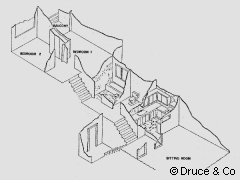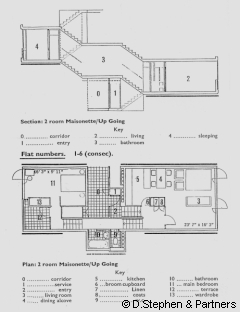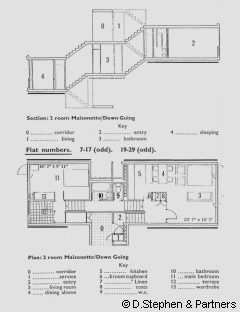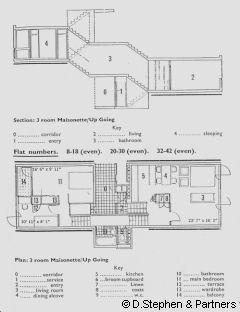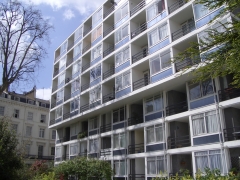"In the 'scissor' section each maisonette interlocks
with its neighbour in three dimensions, approximately
at the point of the 'pin joint' connecting the two
halves of a 'pair of scissors'. In this analogy the
living rooms may be considered as the handles of the
scissor and the bedrooms as the blades. This is of
course an over-simplified picture, as each maisonette
comprises four separate levels. All the levels are
connected to each other in continuous series of
half-storey height staircases. Hence the maisonettes
are either continuously up-going or down-going
according to their position in the building.
In a typical up-going maisonette, for instance, one
enters into a small hall and then one climbs half a
storey to a main living / dining / kitchen level
arranged 'en suite' on the west side of the building.
From this living level one climbs a further half-storey
height to the bathroom and WC, and then a final
half-storey height to the bedroom floor on the east side.
By the use of this section all the units are
through-units with dual aspect, east and west.
Not only does this section provide a desirable
orientation to both living rooms and bedrooms but it
also affords some acoustical isolation within the block,
as all the living rooms are situated over each other
flanking the street side of the building and all the
bedrooms are conversely arranged facing on to the
garden."
Kenneth Frampton provided a diagram to show how the
scissor design works - which, peculiarly, is incorrect.
It shows a down-going apartment with the stairs of an
up-going flat. Consecutive estate agents involved in
marketing the apartments used Kenneth Frampton's
erroneous diagram, until Druce & Company presented a
new plan of the scissor design in 1972. Unfortunately,
Druce's diagram was not correct either, showing an
up-going flat with the stairs of a down-going flat.
Notice the chairs drawn in the living room area of
Kenneth Frampton's diagram. They are Marcel Breuer's
Cesca dining table chairs, and Le Corbusier's Grand
Comfort armchairs.
The following plans and cross-sections may shed some
light on the layout of the apartments at Corringham.

